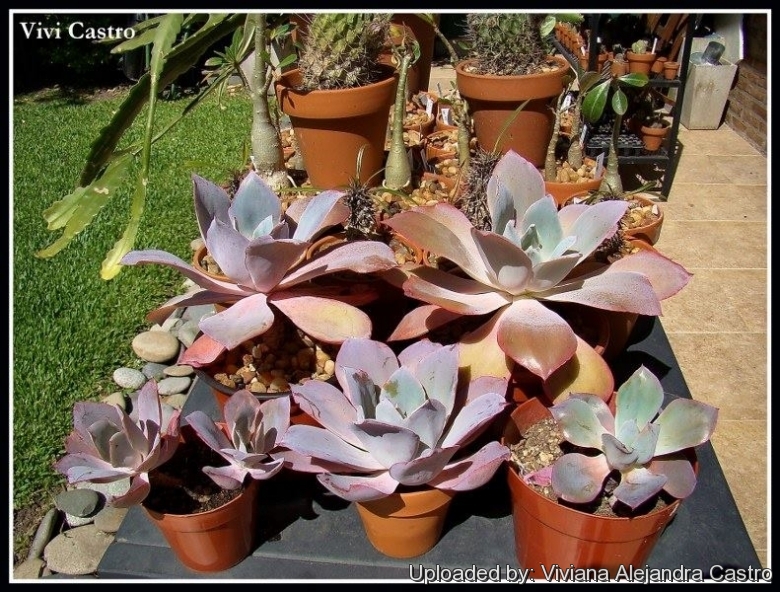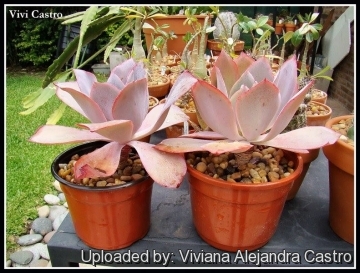




Your support is critical to our success.

Origin and Habitat: Garden origin (Nursery produced cultivar). This hybrid was created by Don Worth, an avid succulent grower and professional photographer in the San Francisco Bay area. Don hybridized Echeveria canteSN|32126]]SN|22248]] (seed parent) with Echeveria shavianaSN|12347]]SN|32126]] (pollen parent) to create both Echeveria 'Afterglow' and its sister seedling 'Morning Light'. At that time, Echeveria canteSN|22248]]SN|22248]] had not yet been named as a separate species and was still thought of as a form of Echeveria subrigida so the parentage was originally given as Echeveria subrigidaSN|32126]]SN|12347]] x Echeveria shavianaSN|22248]]SN|32126]].
Synonyms:
Description: Echeveria cv. AfterglowSN|29489]]SN|29489]] is a very beautiful and vigorous succulent with wide powdery pink and blue pastel leaves edged in bright pink. A stunning plant in all ways, even the flowers and stalks are showy. Its foliage is aptly described as an "out-of-this-world" colour.
Stems: Short stout.
Rosette: 30-40 cm wide.
Leaves: Tapering to a point and covered with a fine white powder. Outer leaves are rosy; inner (newer) ones are bluer, resulting in plants that appear to glow.
Flowers: Deep orange-red emerging from below lower leaves or sometimes as a terminal inflorescence in summer.
Bibliography: Major references and further lectueres
1) San Marcos Growers contributors “Echeveria 'Afterglow'” San Marcos Growers <http://www.smgrowers.com>. Web. 27 Sep. 2014.
2) John Pilbeam “The Genus Echeveria” British Cactus & Succulent Society, 2008
3) Lorraine Schulz and Attila Kapitany "Echeveria Cultivars" Schulz Publishing, 2005
4) “Echeveria 'Afterglow'” at: http://www.pacifichorticulture.org/articles/frilly-echeverias-the-fairest-succulents-of-them-all/#sthash.81Uyp8J4.dpuf

Echeveria cv. Afterglow Photo by: Viviana Alejandra Castro
The gallery now contains thousands of pictures, however it is possible to do even more. We are, of course, seeking photos of species not yet shown in the gallery but not only that, we are also looking for better pictures than those already present. Read More...
Cultivation and Propagation: Echeveria 'Afterglow' is a summer-growing and relatively easy plant thought not the easiest of the echeverias. Thrives in mild climate areas with cool summers and makes great potted specimens.
Soil: Use a very porous soil, which will allow quick drainage. It may thrive in highly alkaline soils with ph between 8 and 8.5, but gives best results in a slightly acidic substrate (ph to 6.5 to 5.5).
Repotting: If potted, repot them preferably in the spring, if their roots become cramped. Generally, they should be repotted every other year in order to provide fresh soil. However, this doesn't necessarily mean they'll need larger containers. Fill about a quarter of the pot with broken crocks, gravel, etc. to promote good drainage. After repotting, do not water for a week or more. Use pot with good drainage. Eventually, as the plant becomes mature grow it slowly, and adopt a new repotting period, using intervals of every 2 - 3 years. Additionally grow it under drier conditions or with stronger sunlight.
Fertilization: Slow release fertilisers with a low to moderate nitrogen content are adequate for the spring and summer growing seasons, and additional fertiliser applications would not required until spring.
Exposure: It can tolerate sun to shade but - generally speaking - the more light a plant gets the better it will display its colours and shape. However, when moving plants from lower light conditions into full sun, be wary of sun scorch, most easily avoided by ensuring plants are well-watered before moving them on a cloudy day. When growing indoors, has a preference for morning light, then bright light throughout the day.
Watering: They can tolerate extended dry periods and survive drought without the need for watering, but they will grow stronger if they receive adequate moisture during their growing season, and never allowing the plant to remain waterlogged. They will rot if kept too wet.
Ventilation: Good air movement is important for minimising pest and disease risks, and avoiding excessive humidity in cool winter conditions is important to successfully growing Echeveria in the nursery environment.
Hardiness: It can tolerate light frosts, but it is best overwintered at 5-10 °C.
With the cooler autumn temperatures tending to make their foliage colours become more intense than those of the active summer growing season.
Pest & disease: This plant is a bit difficult and time consuming echeveria hybrid due to its attractiveness to sucking insects. Aphids like this plant (and all flowering Echeveria). Watch for slugs, worse slug and snail magnets this plant.
Maintenance: Remove older dead leaves that build up at the base. It is best to remove flower stalks as it detracts from the foliage and a terminal flower stalk aborts further growth.
Propagation: Usually by pups. If the plant is repotted some of the bottom leaves can be removed, in order to attempt leaf propagation, it is also a common practice to collect the leaves on the flower stem. However this is not one of the easiest species to root, as many such cuttings will dry out without producing a plantlet, but with perseverance it is likely to get a few new plants.
| Your Actions | |
|---|---|
| Back to Echeveria index | |
| Back to Crassulaceae index | |
 |
Back to Succulents Encyclopedia index |
Privacy stantement - Terms and conditions - How to cite - About us - Feedback - Donate



